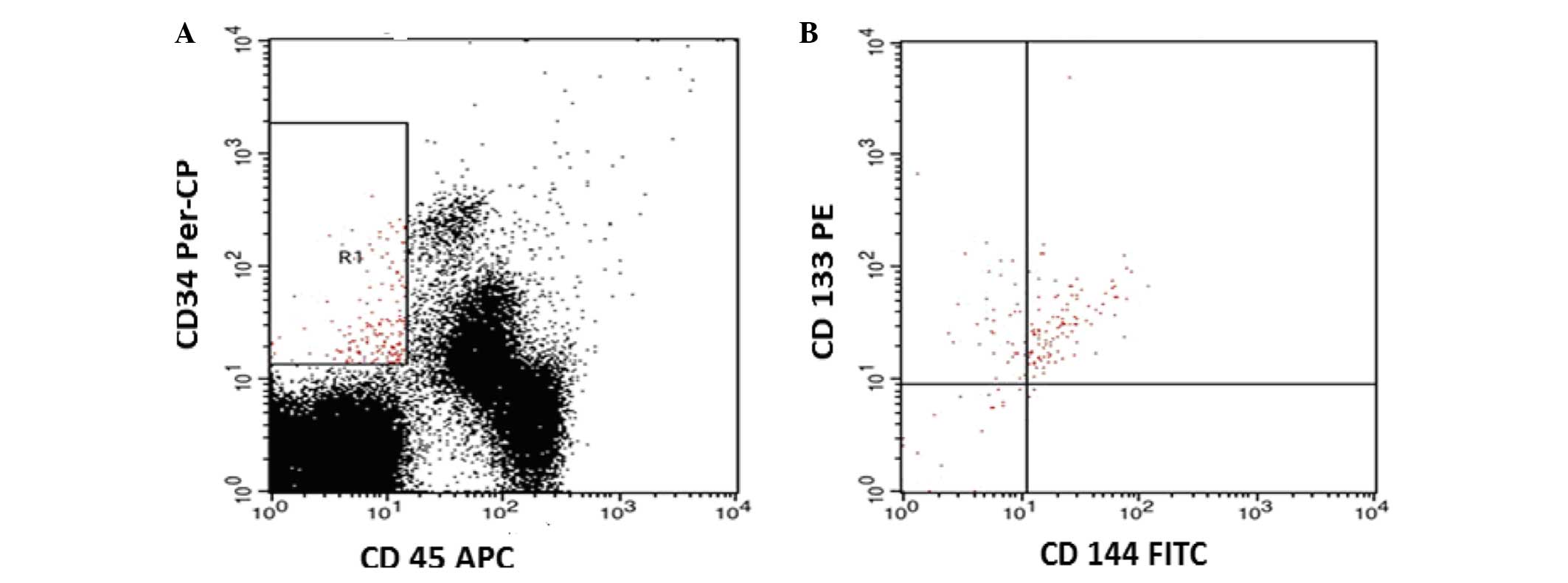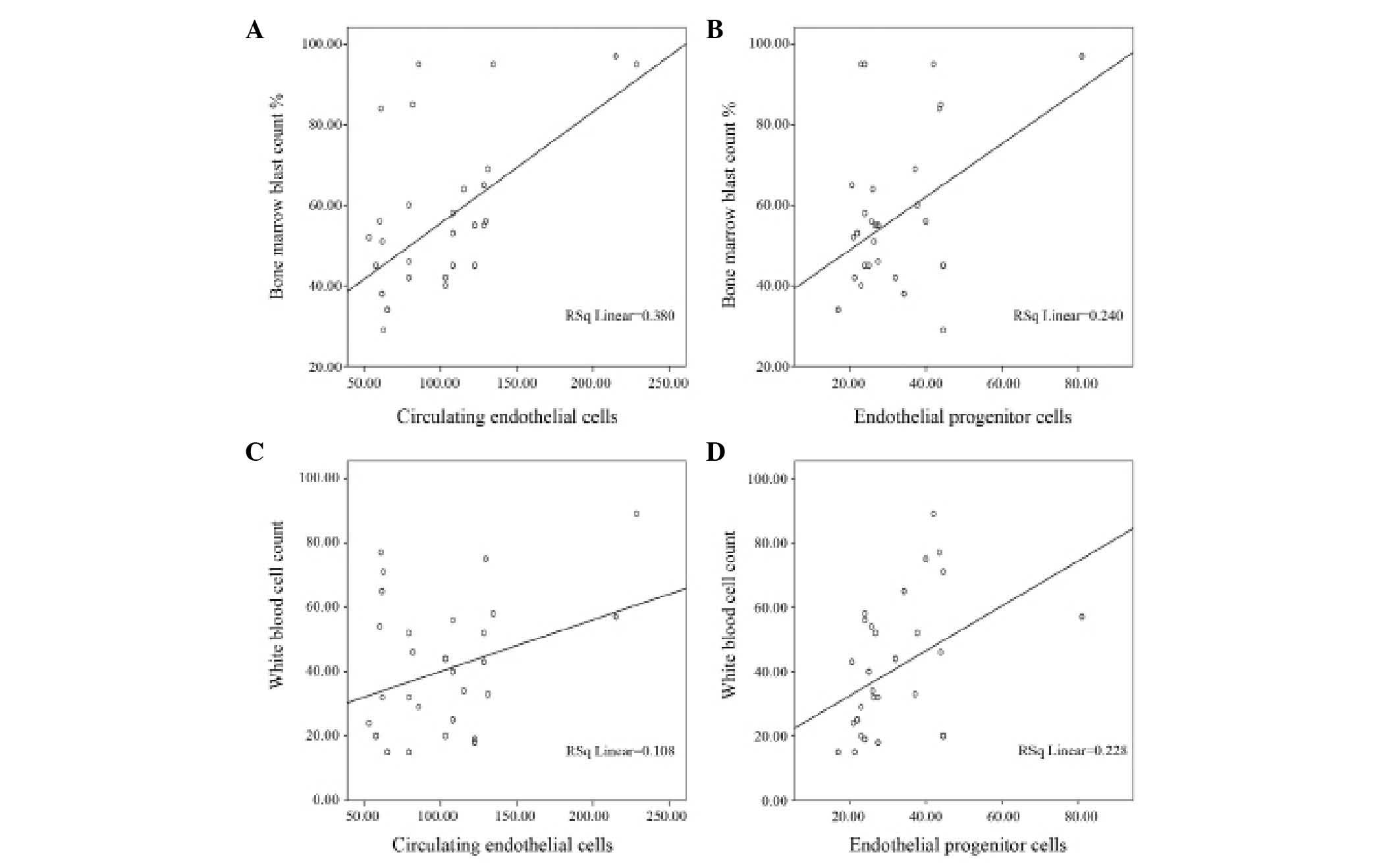|
1
|
Fröhling S, Scholl C, Gilliland DG and
Levine RL: Genetics of myeloid malignancies: Pathogenetic and
clinical implications. J Clin Oncol. 23:6285–6295. 2005. View Article : Google Scholar : PubMed/NCBI
|
|
2
|
Trujillo A, McGee C and Cogle CR:
Angiogenesis in acute myeloid leukemia and opportunities for novel
therapies. J Oncol. 2012:1286082012. View Article : Google Scholar : PubMed/NCBI
|
|
3
|
George F, Brisson C, Poncelet P, Laurent
JC, Massot O, Arnoux D, Ambrosi P, Klein-Soyer C, Cazenave JP and
Sampol J: Rapid isolation of human endothelial cells from whole
blood using S-Endo1 monoclonal antibody coupled to immuno-magnetic
beads: Demonstration of endothelial injury after angioplasty.
Thromb Haemost. 67:147–153. 1992.PubMed/NCBI
|
|
4
|
Blann AD, Woywodt A, Bertolini F, Bull TM,
Buyon JP, Clancy RM, Haubitz M, Hebbel RP, Lip GY, Mancuso P, et
al: Circulating endothelial cells. Biomarker of vascular disease.
Thromb Haemost. 93:228–235. 2005.PubMed/NCBI
|
|
5
|
Bertolini F, Shaked Y, Mancuso P and
Kerbel RS: The multifaceted circulating endothelial cell in cancer:
Towards marker and target identification. Nat Rev Cancer.
6:835–845. 2006. View
Article : Google Scholar : PubMed/NCBI
|
|
6
|
Fadini GP, Losordo D and Dimmeler S:
Critical reevaluation of endothelial progenitor cell phenotypes for
therapeutic and diagnostic use. Circ Res. 110:624–637. 2012.
View Article : Google Scholar : PubMed/NCBI
|
|
7
|
Asahara T, Murohara T, Sullivan A, Silver
M, van der Zee R, Li T, Witzenbichler B, Schatteman G and Isner JM:
Isolation of putative progenitor endothelial cells for
angiogenesis. Science. 275:964–967. 1997. View Article : Google Scholar : PubMed/NCBI
|
|
8
|
Ma J and Waxman DJ: Combination of
antiangiogenesis with chemotherapy for more effective cancer
treatment. Mol Cancer Ther. 7:3670–3684. 2008. View Article : Google Scholar : PubMed/NCBI
|
|
9
|
Almici C, Skert C, Verardi R, Di Palma A,
Bianchetti A, Neva A, Braga S, Malagola M, Turra A, Marini M and
Russo D: Changes in circulating endothelial cells count could
become a valuable tool in the diagnostic definition of acute
graft-versus-host disease. Transplantation. 98:706–712. 2014.
View Article : Google Scholar : PubMed/NCBI
|
|
10
|
Szmigielska-Kapłon A, Krawczyńska A,
Czemerska M, Pluta A, Cebula-Obrzut B, Szmigielska K, Smolewski P,
Robak T and Wierzbowska A: Circulating endothelial cell kinetics
and their potential predictive value during mobilization procedure.
J Clin Apher. 28:341–348. 2013.PubMed/NCBI
|
|
11
|
Ali AM, Ueno T, Tanaka S, Takada M,
Ishiguro H, Abdellah AZ and Toi M: Determining circulating
endothelial cells using cellsearch system during preoperative
systemic chemotherapy in breast cancer patients. Eur J Cancer.
47:2265–2272. 2011. View Article : Google Scholar : PubMed/NCBI
|
|
12
|
Wu JY, Huang L, Zhou JF, Pei RZ, Ma JX,
Zhang PS, Liu XH, Du XH, Chen D, Sha KY, et al: Expression of
BCR/ABL fusion gene in circulating endothelial cells from chronic
myelogenous leukemia patients and its clinical significance.
Zhongguo Shi Yan Xue Ye Xue Za Zhi. 22:927–931. 2014.(In Chinese).
PubMed/NCBI
|
|
13
|
Wierzbowska A, Robak T, Krawczyńska A,
Wrzesień-Kuś A, Pluta A, Cebula B and Smolewski P: Circulating
endothelial cells in patients with acute myeloid leukemia. Eur J
Haematol. 75:492–497. 2005. View Article : Google Scholar : PubMed/NCBI
|
|
14
|
Sanz MA, Grimwade D, Tallman MS, Lowenberg
B, Fenaux P, Estey EH, Naoe T, Lengfelder E, Büchner T, Döhner H,
et al: Management of acute promyelocytic leukemia: Recommendations
from an expert panel on behalf of the European LeukemiaNet. Blood.
113:1875–1891. 2009. View Article : Google Scholar : PubMed/NCBI
|
|
15
|
Cheson BD, Bennett JM, Kopecky KJ, Büchner
T, Willman CL, Estey EH, Schiffer CA, Doehner H, Tallman MS, Lister
TA, et al: Revised recommendations of the international working
group for diagnosis, standardization of response criteria,
treatment outcomes and reporting standards for therapeutic trials
in acute myeloid leukemia. J Clin Oncol. 21:4642–4649. 2003.
View Article : Google Scholar : PubMed/NCBI
|
|
16
|
Mancuso P, Antoniotti P, Quarna J, Calleri
A, Rabascio C, Tacchetti C, Braidotti P, Wu HK, Zurita AJ, Saronni
L, et al: Validation of a standardized method for enumerating
circulating endothelial cells and progenitors: Flow cytometry and
molecular and ultrastructural analyses. Clin Cancer Res.
15:267–273. 2009. View Article : Google Scholar : PubMed/NCBI
|
|
17
|
Chorváth B and Sedlák J: Hematopoietic
cell differentiation antigens (CD system 1997). Cancer research
relevance. Neoplasma. 45:273–276. 1998.PubMed/NCBI
|
|
18
|
Heissig B, Hattori K, Dias S, Friedrich M,
Ferris B, Hackett NR, Crystal RG, Besmer P, Lyden D, Moore MA, et
al: Recruitment of stem and progenitor cells from the bone marrow
niche requires MMP-9 mediated release of kit-ligand. Cell.
109:625–637. 2002. View Article : Google Scholar : PubMed/NCBI
|
|
19
|
Shain KH, Landowski TH and Dalton WS: The
tumor microenvironment as a determinant of cancer cell survival: A
possible mechanism for de novo drug resistance. Curr Opin Oncol.
12:557–563. 2000. View Article : Google Scholar : PubMed/NCBI
|
|
20
|
Damiano JS, Cress AE, Hazlehurst LA, Shtil
AA and Dalton WS: Cell adhesion mediated drug resistance (CAM-DR):
Role of integrins and resistance to apoptosis in human myeloma cell
lines. Blood. 93:1658–1667. 1999.PubMed/NCBI
|
|
21
|
Norden-Zfoni A, Desai J, Manola J, Beaudry
P, Force J, Maki R, Folkman J, Bello C, Baum C, DePrimo SE, et al:
Blood-based biomarkers of SU11248 activity and clinical outcome in
patients with metastatic imatinib-resistant gastrointestinal
stromal tumor. Clin Cancer Res. 13:2643–2650. 2007. View Article : Google Scholar : PubMed/NCBI
|
|
22
|
Buckstein R, Kerbel RS, Shaked Y, Nayar R,
Foden C, Turner R, Lee CR, Taylor D, Zhang L, Man S, et al:
High-dose celecoxib and metronomic ‘low-dose’ cyclophosphamide is
an effective and safe therapy in patients with relapsed and
refractory aggressive histology non-Hodgkin's lymphoma. Clin Cancer
Res. 12:5190–5198. 2006. View Article : Google Scholar : PubMed/NCBI
|
|
23
|
Zhang H, Vakil V, Braunstein M, Smith EL,
Maroney J, Chen L, Dai K, Berenson JR, Hussain MM, Klueppelberg U,
et al: Circulating endothelial progenitor cells in multiple
myeloma: Implications and significance. Blood. 105:3286–3294. 2005.
View Article : Google Scholar : PubMed/NCBI
|
|
24
|
Brown AP, Citrin DE and Camphausen KA:
Clinical biomarkers of angiogenesis inhibition. Cancer Metastasis
Rev. 27:415–434. 2008. View Article : Google Scholar : PubMed/NCBI
|
|
25
|
Rademaker-Lakhai JM, Beerepoot LV, Mehra
N, Radema SA, van Maanen R, Vermaat JS, Witteveen EO, Visseren-Grul
CM, Musib L, Enas N, et al: Phase I pharmacokinetic and
pharmacodynamic study of the oral protein kinase C beta-inhibitor
enzastaurin in combination with gemcitabine and cisplatin in
patients with advanced cancer. Clin Cancer Res. 13:4474–4481. 2007.
View Article : Google Scholar : PubMed/NCBI
|












